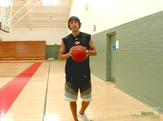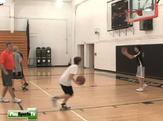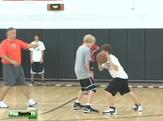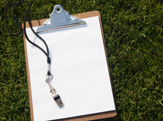PlaySportsTV Basketball
Basketball Shooting Tips from the NBA's Shot Doctor
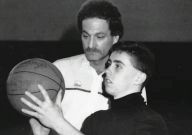
Buzz Braman, rear, works with a youth basketball player
By Matt Herb
Special to PlaySportsTV
Buzz Braman was a youth basketball player with a lousy jump shot when he walked into a gymnasium and had a realization that would change his life.
Braman was practicing as usual when he noticed his shooting motion consisted of five parts and that his accuracy improved as he focused on performing those parts. In the months and years that followed, he developed his brainstorm into what would become “The Braman Method,” a basketball shooting system that corrects flaws and helps players to become more consistent.
Braman is living proof the system works. He once made 738 consecutive free throws, and at a Philadelphia 76ers rookie camp he hit 246 of 250 3-point attempts, including his first 92 in a row.
These days, he teaches proper technique, including the importance of the non-shooting hand, at his basketball shooting camps and in clinics. His students range from kids just starting out all the way up to NBA stars like Shaquille O’Neal.
The NBA's first full-time shooting coach discusses his basketball tips for youth coaches and players:
PlaySportsTV: How did you learn to shoot as a kid?
Braman: I actually figured it out by accident when I was 13 years old in a gym one day. I just understood that there were five main parts of the shot, and I kind of sorted it out. You’ve got to understand that my dad is a federal judge. My brother and I were raised to think very logically. And I literally had an epiphany one day in the gym because I couldn’t shoot at all. It was the worst part of my game. But I ended up figuring it out. When I walked out of the gym, I had this new style, a new method of shooting that I did every day for three or four hours at a clip. Within three weeks, it was over. I had it. What I teach NBA players today is what I figured out in the gym.
PSTV: How did you get into basketball coaching?
Braman: When I was done playing ball, I was in the car business in Miami for 10 years until I had the brainstorm one day. The NBA stats were so bad – field goal percentage and free throw shooting. I was just thumbing through a magazine and thought, ‘Oh my God, that stuff I figured out way back then, I could turn it into a business.’
PSTV: What kind of youth basketball drills do you do?
Braman: I do camps. I love working with kids. I’ve been doing that for 18 years. One of the main reasons why 99.9 percent of all kids can’t shoot is because you can’t take a 7-year-old kid to a 10-foot basket with a normal-sized ball. The first thing they’re going to do is put one hand on side of the ball, put the other hand on the other side of the ball, then take the ball to their chest and heave it with both hands. So the bad habits start really early, and very rarely do they get broken.
PSTV: How much of the basketball drills involve correcting bad habits?
Braman: I don’t want to say that’s all it is, but it’s 99.9 percent. If you have perfect form – and most of the people involved in basketball have no idea what it is – you’re going to shoot the ball at such a high level it’s frightening.
PSTV: What’s a good age for kids to start focusing on their basketball shooting?
Braman: I think you can do it at a young age, 8 or 9. I had a 9-year-old I taught, and after three months of reconstructing his shot he made 43 foul shots in a row on an eight-and-a-half-foot basket. But he was pretty focused and he loved it. The problem is, when kids are really young, the game should be fun. Kids shouldn’t feel like they’re working and that it’s torturous when they’re playing basketball. Ten or 11 is a really good time to lock in what’s correct.
PSTV: What are some of the essentials of basketball shooting?
Braman: I can’t give it all to you, but I can give you two main ones out of the five parts of the shot. Number one: When you lift your ball up to shoot, it starts waist-high if you visualize holding a ball. What you’re going to do is raise it up. If you were to lift it to head level or a little bit above, the shape of your shooting arm, between your forearm and the rest of your arm, should form a backward letter ‘L.’ Most kids will take the ball when they start, and the ball will come back to their chest, underneath their chin area. When they were little, that’s what they had to do for power. When you collapse the ball to your body, you don’t get that perfect letter ‘L.’ What you get is a ‘V.’ When you have a ‘V,’ you’re dead. It just doesn’t work.
The number two factor is what happens with your left hand, or the hand that doesn’t shoot. Ninety percent of basketball players do that hand incorrectly. When you’re done shooting the ball, the hand that doesn’t shoot should not be facing the basket in any way, shape or form. But almost 100 percent of all kids use that hand to shoot, to push. That causes the ball to go off-line, which is a terrible problem most players have. A lot of NBA guys have it, too.
PSTV: Which NBA players should youth basketball players watch to understand good shooting form?
Braman: Back in the day, I would have told you to watch Chris Mullin. He was probably the best shooter in history. He was not pretty good, he was great. Today, if you were watching on TV, (Richard) "Rip" Hamilton has pretty good form. Ray Allen has pretty good form, too.
###
Learn the best coaching techniques through PlaySportsTV basketball training plans.


